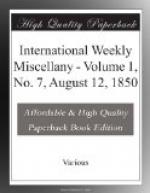In the cloisters of her bosom, with a secret, tender thrill,
When the hay again has blossomed, and the valley stands in corn,
Shall the bells of Santa Clara usher in the wedding morn.
He has pictured the procession, all in holyday attire,
And the laugh and look of gladness, when they see the distant spire;
Then their love shall kindle newly, and the world be doubly fair,
In the cool delicious crystal of the summer morning air.
Tender eyes of Manuela! what has dimmed your lustrous beam?
’Tis a tear that falls to glitter on the casket of her dream.
Ah, the eye of love must brighten, if its watches would be true,
For the star is falsely mirrored in the rose’s drop of dew!
But her eager eyes rekindle, and her breathless bosom stills,
As she sees a horseman moving in the shadow of the hills;
Now in love and fond thanksgiving they may loose their pearly tides—
’Tis the alazan that gallops, ’tis Bernardo’s self that rides!
[Footnote 5: In California horses are named according to their color. An alazan is a sorrel—a color generally preferred, as denoting speed and mettle.]
[Footnote 6: The sarape is a knit blanket of many gay colors, worn over the shoulders by an opening in the center, through which the head is thrust.]
[Footnote 7: Calzoneros are trowsers, generally made of blue cloth or velvet, richly embroidered, and worn over an under pair of white linen. They are slashed up the outside of each leg, for greater convenience in riding, and studded with rows of silver buttons.]
[Footnote 8: The lariat, or riata, as it is indifferently called in California and Mexico, is precisely the same as the lasso of South America.]
* * * * *
FROM FRASER’S MAGAZINE FOR JULY.
LEDRU ROLLIN.
Ledru Rollin is now in his forty-fourth or forty-fifth year, having been born in 1806 or 1807. He is the grandson of the famous Prestidigateur, or Conjurer Comus, who, about four or five-and-forty years ago, was in the acme of his fame. During the Consulate, and a considerable portion of the Empire, Comus traveled from one department of France to the other, and is even known to have extended his journeys beyond the Rhine and the Moselle on one side, and beyond the Rhone and Garonne on the other. Of all the conjurers of his day he was the most famous and the most successful, always, of course, excepting that Corsican conjurer who ruled for so many years the destinies of France. From those who have seen that famous trickster, we have learned that the Charleses, the Alexanders, even the Robert Houdins, were children compared with the magical wonder-worker of the past generation. The fame of Comus was enormous, and his gains proportionate; and when he had shuffled off this mortal coil it was found he had left to his descendants a very ample—indeed, for France, a very large fortune. Of the descendants in a right line, his grandson, Ledru Rollin, was his favorite, and to him the old man left the bulk of his fortune, which, during the minority of Ledru Rollin, grew to a sum amounting to nearly, if not fully, L4,000 per annum.




